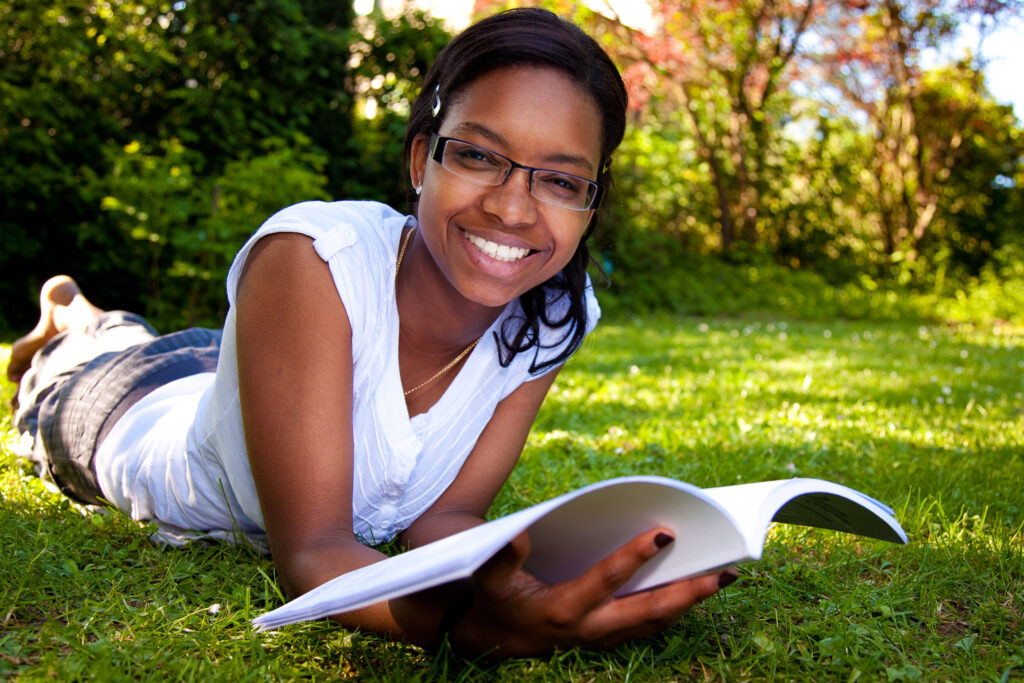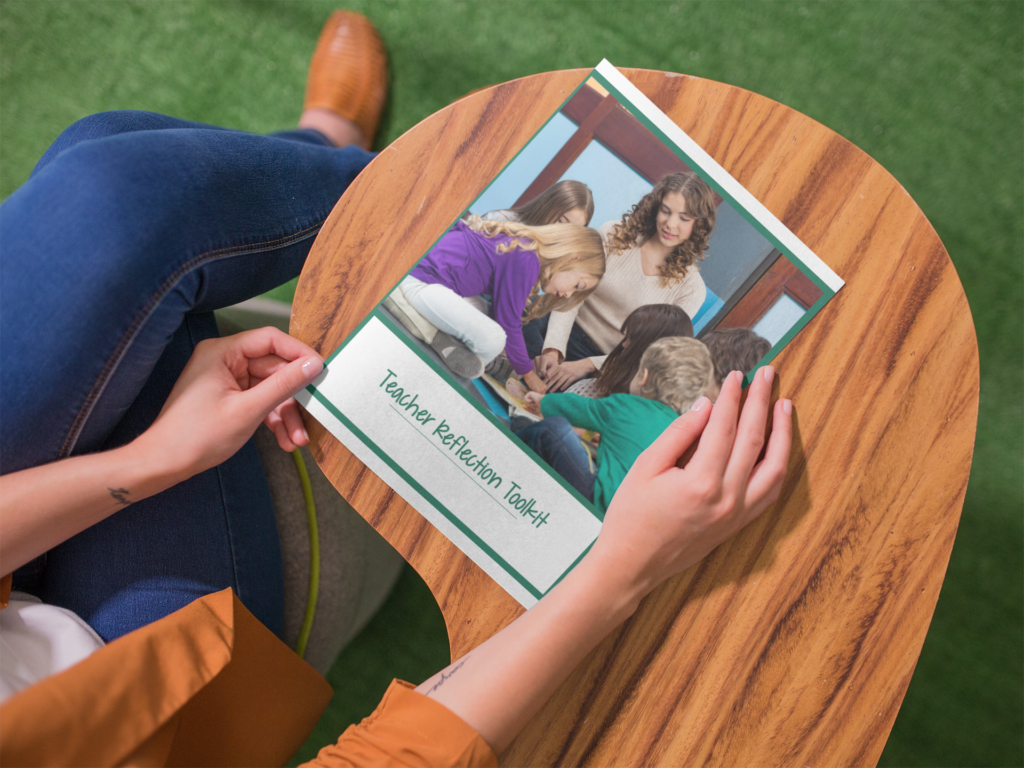Inside: Discover why it’s important for educators to make a commitment to read professionally and find a list of my favorite early childhood teacher books that have both inspired and transformed my teaching.
Note: Some of the links in this post are Amazon affiliate links. If you click on the link and purchase the item, I will receive a small commission at no extra cost to you. The links are included to provide easy access to items I have personally chosen, purchased and used in my own classroom.

Why Read Teacher Books?
There is no shortage of things for teachers to read. Social media posts, articles, newsletters, and workshop handouts are all vying for our time. As a result, we’ve become really good skim readers, scanning quickly over text, looking for a “quick win,” that we can use in our classroom tomorrow. In fact, right now you are probably thinking, “Get to the teacher books already, will ya?”
But here’s the thing.
This type of bounce here, bounce there reading, keeps us from going deeper. We miss opportunities to connect and grow with the writer as they describe their experiences, thoughts, and reflections. When we take the time to really digest what we are reading, it informs our practice in a way that a “quick win” can’t. We love the “how,” but really need to understand the “why,” in order to become well-read teachers that can articulate why we do what we do in the classroom.
Finding the Right Teacher Books
When we choose to read a complete teacher book, we are making a commitment. We are open to slowing down, letting the author’s thoughts and ideas move through us and land somewhere. We are showing up, time and time again, with the hope of being both inspired and transformed.

A great teacher book can do two things:
- It affirms what we are already doing. (Yeah, I got this!)
- It challenges our thinking and practices. (Oh, no I’ve got work to do.)
Finding the right books is as simple as choosing a topic we are interested in or an area in which we want to grow. Then, asking around to find book recommendations from other teachers. Below is a list of teacher books, organized by subject area, that have made me go, “hmmmm,” and ultimately transformed my teaching.
K-2 Professional Books by Category
Classroom Environment
These books will help you think through the important aspects of setting up a space for learning. Each offers beautiful photos of classrooms as well as the “why” behind the furniture, materials, colors, and more.
- Rethinking the Classroom Landscape by Sandra Duncan, Joy Martin, and Rebecca Kreth
- Designs for Living and Learning: Transforming Early Childhood Environments by Deb Curtis and Margie Carter
- Strategic Classroom Design: Creating an Environment for Flexible Learning by Jessica Martin
Play-Based Centers
Each of these books makes a much needed case for play and open-ended centers in early childhood classrooms. All explore the mindset of “play” and what children learn in this type of environment.
- Choice Time: How to Deepen Learning Through Inquiry and Play by Renee Dinnerstein
- Purposeful Play by Kristine Mraz, Alison Porcelli, and Cheryl Tyler
- Makerspaces: Remaking Your Play and STEAM Early Learning Areas by Michelle Kay Compton and Robin Chappele Thompson
- Joyful Math: Invitations to Play and Explore in the Early Childhood Classroom by Deanna Pecaski McLennan
Inquiry-Based Learning
Check out these books if you are interested in establishing an environment of inquiry, where your teaching is influenced by children’s ideas, interests, and questions.
- Inquiry Mindset by Trevor Mackenzie and Rebecca Bathurst Hunt
- Inquiry Based Learning Environments by Susan Stacey
- The Power of Questioning: Guiding Students’ Investigations by Julie V. McGough and Lisa Nyberg
- Young Investigators: The Project Approach in the Early Years by Judy Harris Helm and Lillian Katz
- The Curious Classroom by Harvey Smokey Daniels (For my reviews of each chapter, visit the Book Study)
Reading
Here you’ll find books that help you create a reading environment that is educationally sound, but developmentally appropriate for young children. None offer the complete answer for what might take place in your kindergarten literacy block, but each offers amazing ideas and food for thought that will help you plan your own effective and engaging reading experiences for the littles.
- Shifting the Balance: 6 Ways to Bring the Science of Reading into the Balanced Literacy Classroom by Jan Burkins and Kari Yates
- 7 Mighty Moves by Lindsay Kemeny
- Reading Above the Fray by Julia Lindsay
- Story Workshop by Susan Harris MacKay
- Story Making by The Maker Movement Approach to Early Literacy for Early Learners
Note: If you are looking for great programs for phonological awareness, I highly recommend both Wilson Fundations and Heggerty. Both are highly structured and systematic, but provide the “roots” children need to build reading foundational skills.
Writing
Young writers need both direct instruction of foundational skills along with opportunities to take writing risks, make approximations, and experiment with expressing their ideas. There isn’t one book here that does all of that, but in combination, they offer a comprehensive guide to early writing.
- A Teacher’s Guide to Getting Started with Beginning Writers by Katie Wood Ray
- About the Authors by Katie Wood Ray
- Basic Tools for Beginning Writers by Betty Schultze
- Talking, Drawing, Writing: Lessons For Our Youngest Writers by Martha Horn and Mary Ellen Giacobbe
Math
What I’ve chosen to share here are my favorite books of math routines, that both build number sense and help young children think and talk about math practices.
- Choral Counting and Counting Collections by Megan Franke and Elham Kazemi
- Number Sense Routines by Jessica Shuway
- Early Childhood Math Routines by Antonia Cameron
- Well Played: Building Mathematical Thinking Through Number Games and Puzzles by Linda Dacey, Karen Gartland, and Jayne Bamford Lynch
Science
It was difficult to decide which books to choose, for bringing young children together with science is dear to my heart. But of those I did select, each is rooted in inquiry, offers hands-on ideas, and helps children connect to the natural world.
- Discovering Nature with Young Children by Ingrid Chalufour and Karen Worth
- Starting with Science by Marcia Talhelm Edson
- Teaching STEM Outdoors by Patty Born Selly
- To Look Closely: Science and Literacy in the Natural World by Laurie Rubin
Becoming a Well-Read Teacher
If you are still reading this post, then you are investing in your professional growth. Hopefully, you connected with something I have written.
But, let’s explore the alternative for a minute. You quickly skimmed the post, clicked through to Amazon, ordered the first book that caught your eye and then, bounced on over to Facebook to check your feed. But when that book arrives, what will motivate you to actually read it? If you didn’t digest the “why” of this post, there’s a good chance that book will just sit on your shelf along with all your other “quick wins.”
Make a commitment today to become a well-read teacher. Choose one book each summer, season, or year to explore fully. Read it with a friend and have rich conversations over lunch about the parts that resonated with you. Take all that deep learning and use it to inspire a change you will make in your classroom. Go for the “big win,” rather than the quick “win.”
And here’s a FREE Teacher Reflection Toolkit you can use to reflect on your current instructional practices and set goals for improvement.

Happy reading!
For more tips on teacher self-care and professional growth, click on the Growing as an Educator page in the Roots & Wings Resource Library.
This post contains affiliate links. Roots & Wings is a participant in the Amazon Services LLC Associates Program, an affiliate advertising program designed to provide a means for sites to earn advertising fees by advertising and linking to Amazon.com.


 The Magic of the Happy Teacher List
The Magic of the Happy Teacher List Curious Classroom Book Study: Lean Into a Crisis
Curious Classroom Book Study: Lean Into a Crisis Playful Encounters with the Reggio Emilia Approach
Playful Encounters with the Reggio Emilia Approach Curious Classroom Book Study: Capture and Honor Kids’ Questions
Curious Classroom Book Study: Capture and Honor Kids’ Questions